Detroit's new restaurants lack diversity among patrons — and that's a problem
Colorful murals of Black women with ebony skin and natural hair flash past my window as I zip down the street for dinner in greater downtown Detroit, the 7.2 square miles garnering many of the city’s new restaurant openings.
I turn down streets named after Black civil rights activists and Motown legends and drive through neighborhoods that pay homage to African American inventors and pioneers. At restaurants I visit often, there’s usually a local face who has become familiar — the brown-skinned man dancing on the grass, the young Black street ministers preaching the word of God.
Detroit is a Black city, if not for the people who have contributed to the arts and infrastructure of the city, for its very demographic makeup — nearly 80% of Detroit’s population is Black. And yet, it appears, so few restaurant consumers in greater downtown Detroit are Black.
In eateries in metro Detroit, cities like Dearborn and Hamtramck, where large populations of Arab Americans reside, new restaurants are brimming with diners reflective of the surrounding neighborhoods. Apart from the stretch of Black-owned restaurants along Livernois in northwest Detroit, however, there are few new establishments whose dining rooms reflect the majority-Black city at large.
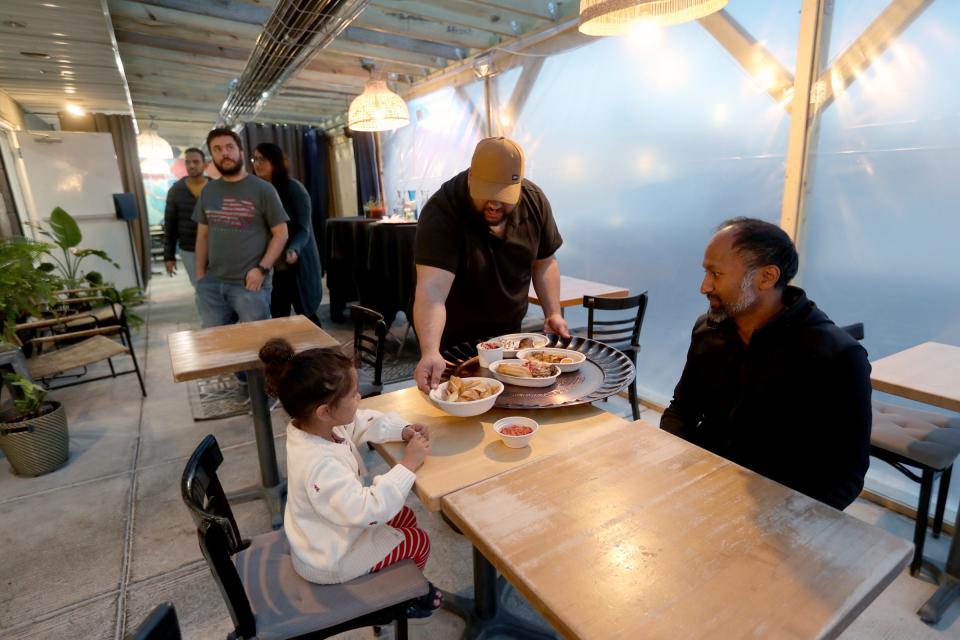
“If you have a restaurant in a predominantly Black city and you don’t have diners of color frequenting your place, there is a problem,” said Omar Anani, chef and owner of Saffron De Twah — one of the Free Press Best New Restaurants of 2020. Minutes from Eastern Market, Saffron De Twah is one of few spaces that draw a diverse crowd in greater downtown, the collection of central neighborhoods including downtown, Midtown, Woodbridge, New Center, Eastern Market, Lafayette Park, Rivertown and Corktown.
Unexpected isolation
Crossing the threshold into a new restaurant in greater downtown often feels like stepping into an alternate universe so unlike the city that surrounds it, it’s as though I’ve time traveled. With my Black husband as my usual dinner companion, our table for two often sits like a life raft in a sea of white diners.
Lightbulb moments flicker in the room when a person of color becomes aware that they’re the minority in the space. Those moments then become the topic of conversation in our homes, between friends and among strangers looking to forge a common bond — we all have a story of isolation.
I’ve experienced those moments for as long as I can remember — as one of a handful of Black gymnasts in elementary school, as one of two Black cheerleaders in high school, as one of three Black students of more than a hundred in a study abroad program, as the only Black editor at a magazine.
Detroit, however, whose greatest strength might be its rich Black history and landscape of Black men and women, is the last place I anticipated feeling othered.
Chefs and restaurateurs have shared their concerns about the lack of diversity in their spaces with me. Standing in a buzzing fine dining room one evening where I spotted just one Black woman dabbing her mouth with a napkin between courses, even the restaurant's white owner acknowledged the matter of race. Despite being mindful of cultivating a welcoming environment, with his arms folded across his chest, he admitted he’d never imagined his dining room would look like this, nodding to the room filled with white patrons with early reservations, likely aiming to make it back to their suburban homes before dark. (Downtown, this pattern has earned areas like the Capitol Park district the moniker "Birmingham South" for attracting herds of suburb-dwellers chasing a taste of city life on special occasions.)
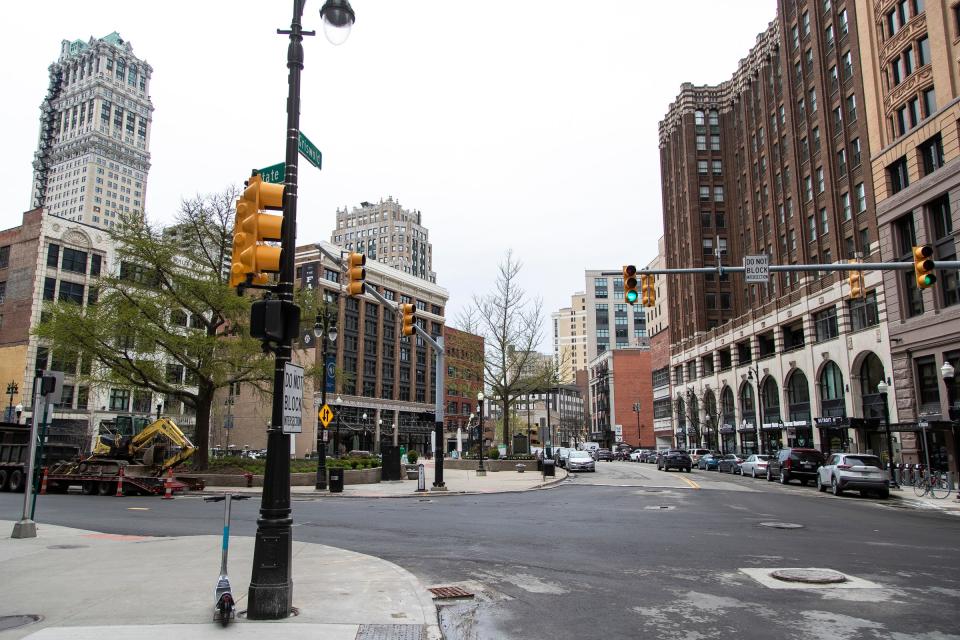
And then there are the friends and family members who’ve felt so out of their element, they tend to avoid some dining experiences altogether.
Being the only person of color in a restaurant is similar to being over- or underdressed. Except in this instance, there’s no coming better prepared with a more appropriate outfit the next visit. Once you realize your out-of-placeness isn’t temporary, you might concede to the idea that you’ll never fit in. Not this dinner, and maybe not ever.
Serving the community
It would seem intuitive, if not rudimentary to building a successful business, for restaurateurs to survey the wants and needs of a community before breaking ground on a new venture in an existing neighborhood. Instead, the fundamentals of gentrification have seemingly become more commonplace. If there is a genuine intention to forge a diverse and inclusive dining room, however, this upfront consideration of the inhabitants of a neighborhood could become the cornerstone of progress.

If restaurateurs are not tapping into the people in the neighborhood to find out what they want in a local eatery, Thor Jones, general manager at New American tasting menu restaurant Freya and founder of Hospitality Included, says there's an issue.
"If you're a white man or woman opening up a restaurant with flavor profiles that you grew up on in a space where nobody looks like who you grew up around, it's a simple equation."
Jones said there has to be more intention when opening a space, particularly in neighborhoods that haven't gone through the gentrification that downtown has.
Surveying neighborhoods for residents' flavor preferences is a step toward inclusion. Diversifying kitchens where Black and brown cooks lend their palates to influence ingredient choices and menu items also offers an opportunity for true cultural exchange through culinary art.
“It's interesting to weave together the African diaspora and look at how food came to the United States and how it also influenced food across the world,” said Kiki Louya, a chef, food and labor activist and former executive director of the Restaurant Workers’ Community Foundation.
“There are a lot of similarities with African, Caribbean and cuisines outside of the Americas, but also within the American South, which represents a huge swath of Detroiters across generations whose families migrated from the South. Allowing people to make those cultural connections through food in your establishment — even if it's just a special — is a way to connect.”
Louya cautions against cultural appropriation.
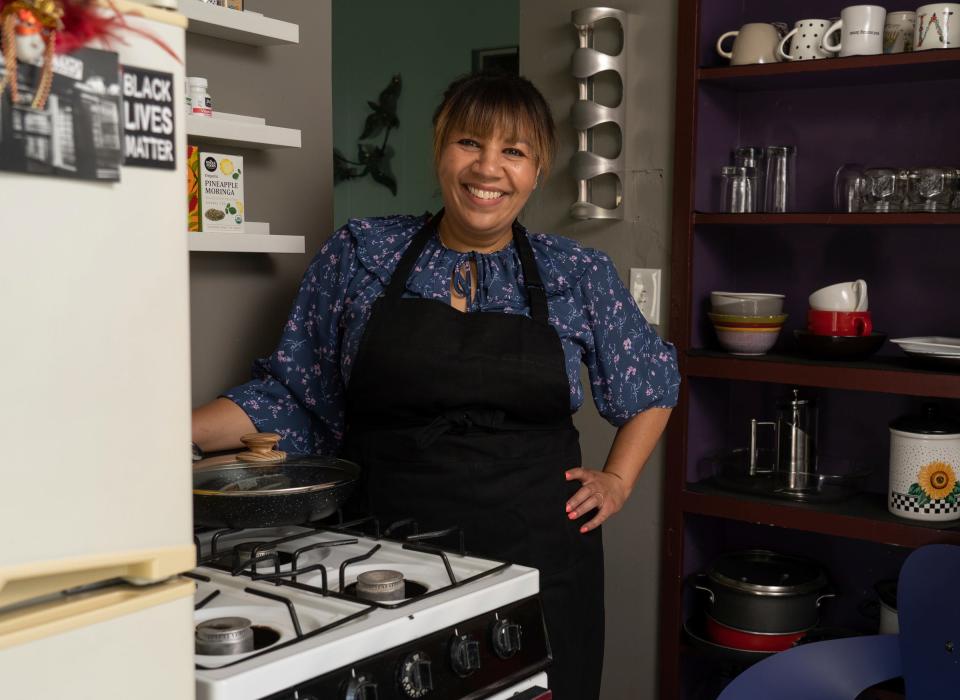
“I’m not asking a restaurateur to create a soul food restaurant — in fact, I’m really saying, please don’t, unless you have the education and a thorough appreciation,” she said. “What I'm asking for people to do is to look at how their spaces currently operate and figure out how to make them more inclusive. We all say food is a connector, so let's use it. It shouldn't just be a connector to the people who you feel are worthy of connecting with.”
Rebecca Irby said much of her work as director of programs and services at New Detroit, a racial justice organization, is based on intervention once a business recognizes its diversity and inclusion blind spots.
“If people of color weren’t in mind when the space was created,” she said, “then we’re in the position that we’re in right now. We’re trying to add things to make it seem more welcoming when its creation and its concept did not include Black and brown people.”
She looks to highly gentrified neighborhoods like downtown Detroit as areas in need of “intense intervention,” and hopes efforts to implement diversity, equity and inclusion initiatives among new businesses will be collaborative.
“Transformation can happen more easily when more people are involved,” she said.
Cultivating inclusion
Louya has seen and experienced the lack of diversity in Detroit dining rooms firsthand as a restaurateur and as a biracial diner.
“People feel comfortable and welcome where they feel represented,” she said, adding that age and sex are factors to consider when thinking about diversity.
One way to begin to create a welcoming environment, Louya said, is to diversify the service staff, the first faces a diner sees when entering a restaurant. “When you come in and you see someone who looks like you in a space, you feel at ease,” she said.
Irby agreed. “You want your staff to be reflective of the city and the space where you are,” she said.
There are implications to consider when hiring Black and brown service workers, though. If the clientele of a space is overwhelmingly white and front-of-house workers are Black, restaurateurs risk the perception that the only place for people of color is to be of service to white diners.

According to The State of the Restaurant Workers 2020 report by the Restaurant Opportunities Center United, Black workers are the majority, with more than 76% making up the total restaurant workforce in Detroit. Nationwide, a study by the Multicultural Foodservice & Hospitality Alliance and People Report in 2014 showed African Americans accounted for 16% of hourly restaurant employees, but only 7% of managers.
Industry professionals like Jones are developing opportunities to help close this gap by encouraging Black restaurant workers to pursue long-term career paths in hospitality. The inaugural iteration of Full Hands In, Full Hands Out, a five-day training session that launched this spring, was designed by Jones to create a sustainable pipeline for Black management and ownership.
“Don't get me wrong, walking into an establishment and seeing people that look like you working there definitely has a lot to do with making any demographic comfortable in your space,” Jones said to the restaurateurs making efforts to hire workers of color. "But if that's about as far as you're going, then you’re not doing enough.”
Carving out support
For a Black diner, there is a level of comfort in a room where Black hosts greet you at the door, where Black servers are jotting down your order and Black bartenders are shaking your craft cocktail. What, though, is the comfort level for a worker at a restaurant without broader methods for diversity and inclusion?
More from Lyndsay Green:
At Mumma Maria's House in Detroit, every dish honors mom
‘Bad Axe’ isn’t about a Michigan city — it’s about a Michigan immigrant family
“When it comes to diversity, it's not just about checking the boxes and hiring more people of color,” Louya said.
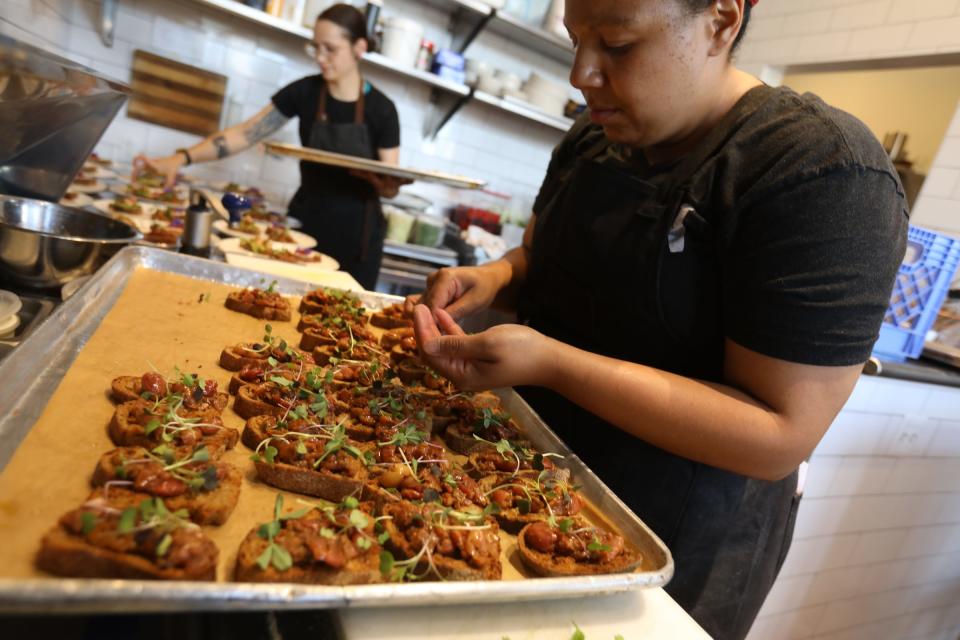
She challenges business owners to uphold practices that are supportive of Black and brown workers.
“You can hire them, but then your practices internally are oppressive enough that there are microaggressions left and right and they are disrespected and they are not given support that is indicative of an understanding of where they come from so that they can succeed,” she said.
This oversight risks high turnover rates, or worse, a toxic culture for Black food service workers.
“What else are you doing in order to attract a more diverse workforce and what are you doing to retain them?” Louya asked.
At Freya, the support of ownership has afforded Jones the opportunity to offer input for ways to forge a more diverse and inclusive environment that is reflective of the predominantly Black Milwaukee Junction neighborhood where the restaurant resides.

“The first thing that has to change is restaurateurs believing that their sales can come from the neighborhoods and from Black diners,” he said.
The power, Jones said, is in programming.
“There are a lot of influential Black people who could pack a restaurant three times over on a slower day and would bring a whole different demographic that probably would never know about your restaurant,” Jones said. “That's what I think needs to be happening if we're talking about making a restaurant a place that reflects the community that you're in.”
On a Tuesday night in late April, hip-hop blared inside Dragonfly, Freya's next-door neighborhood bar concept. Shell Shock’d Tacos, the Black-owned Hubbard Richard taqueria, popped up to celebrate Taco Tuesday. Each table is topped with golden griddled tortillas filled with Nashville hot chicken and butter pickles and birria with cilantro and onions. Silky consommé is ladled into small Styrofoam cups for dipping. There are spicy mango Sriracha margaritas and hunks of chopped elote coated in Cotija.
Most notably, though, the space is jam-packed, and young Black diners are the majority.
The gold standard
On any given night, under a covered patio on Detroit’s east side, Saffron De Twah diners are a kaleidoscopic vision. Black, white and Middle Eastern guests take wide bites of crispy Moroccan chicken sandwiches topped with purple cabbage curls, creamy harissa potatoes and hearty tagine dishes. Hot tea is poured in the relaxed setting.
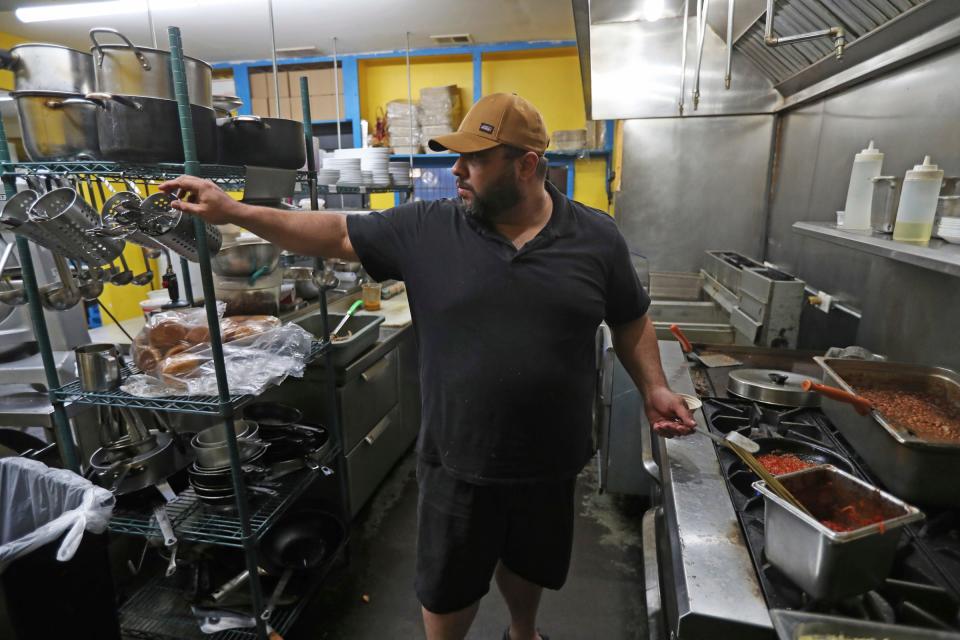
Before becoming a James Beard Award-nominated, full-service restaurant, the Gratiot Avenue space was where Anani parked the eatery’s food trucks. It’s also where Anani engaged the Gratiot-Grand and neighboring communities well before opening Saffron De Twah’s doors.
“I had the benefit of owning my building for years before opening to the public,” he said. “We hired multiple people from the area. We did studies of the market. We did business in the neighborhood.”
Anani says he went door to door to meet neighbors — “not to solicit them, but to say, ‘Hi, I’m in the neighborhood. Come have a cup of tea.’ ”
The diverse dining room at Saffron De Twah evidences the potential of a community-first approach in greater downtown.
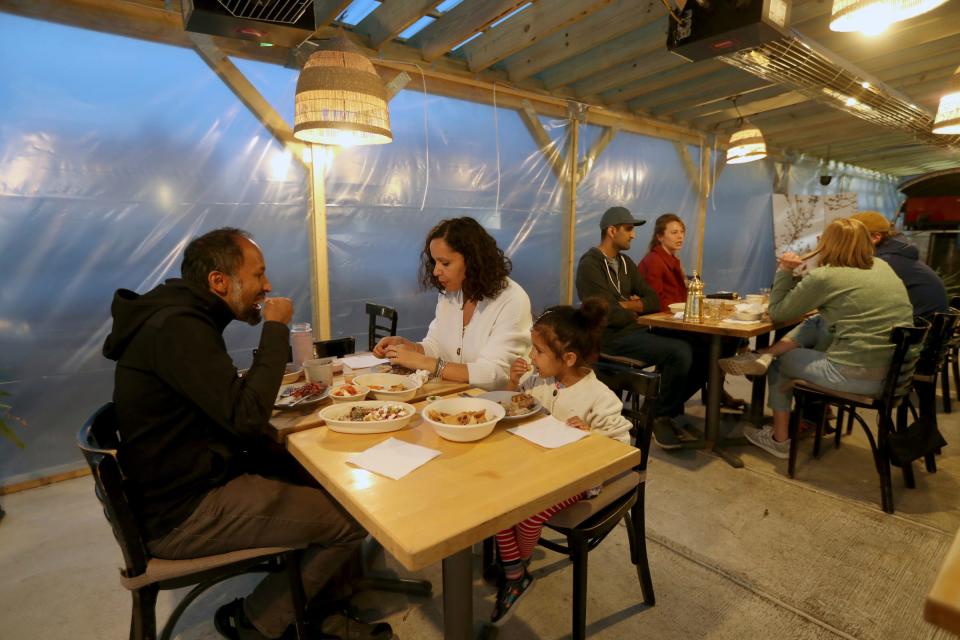
“If you walk into a restaurant and ask a host, ‘Who do you work for?’ they will say the name of the manager or restaurant," Anani said. "If you ask the manager the same question, they say the name of the owner. If you ask the owner, the response is, ‘Myself.’ This is toxic if you truly want to serve the community.”
When Anani poses the same string of questions to himself, he says: “I work for my leaders. My leaders say, ‘I work for the team.’ The team says, ‘I work for the guest.’”
Anani says the culture shift at Saffron De Twah is centered on the diner, not a hierarchy among the staff.
“Notice how the terms we apply — ‘leaders,’ ‘team members’ and ‘guests’ — are different than ‘managers,’ ‘staff’ and ‘customers,' " he said. "They might look the same, but the connotation is very different.”
In his prophetic 2017 article titled “The Whitewashing of Detroit’s Culinary Scene,” the cook, artist, prolific writer and former Detroit resident Tunde Wey said:
"In today’s Downtown Detroit, the majority of new restaurant ownership — along with the bulk of prestigious staff positions at these establishments — is overwhelmingly white. So is their patronage. With a few important and notable exceptions, Downtown Detroit’s contemporary culinary scene, as celebrated by popular media coverage, investment capital, and growing industry recognition, is almost exclusively white-faced in a breathtakingly black city — and adjacent to other similarly white-faced commercial and residential concerns. This inequality is the final destination for most urban revival schemes, a sad union of capitalism and structural racism that’s hard to untangle."
Less than five years ago, Wey gazed into a future not unlike the dining scene of today. A scene that is often lauded as “thriving!” “bustling!” and “up and coming!” yet riddled with segregation cloaked in smiles. What is the measure of success when the majority of people in the city are not present in these spaces? Who benefits from the restaurant boom if not the people who live here?
These questions linger each time I step outside of a restaurant in greater downtown Detroit, and into a more realistic version of the Detroit that I've come to know. The Black Detroit where I feel I belong.
This article originally appeared on Detroit Free Press: Detroit's new restaurants lack diversity among customers

